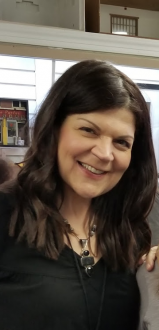Since 1976, Fairfield University has offered a certificate in interior design program for students, mostly adults, who are seeking formal training and certification in the field. It has grown exponentially over the years under the able stewardship of Robert Hardy, who has served as director of Interior Design Certificate Programs at Fairfield University’s College of Arts & Sciences for more than four decades.
The program has produced scores of design professionals who have gone on to open their own studios or obtain gainful employment with larger architectural and design firms, building construction firms and retailers. Intrigued by this local resource for aspiring design professionals, we recently spoke with Hardy:
How is it that you came to develop the certificate program in interior design?
“I had a professional design practice and a female professor at Fairfield University, who taught the very first course in the program, asked me if I would like to teach a class. In spring of 1977 I taught one course, that led to two and it just evolved from there.
“I discovered that I really loved academia and working with students. I retired from my practice to do it fulltime and it really changed my life. My mission was to try to turn it into something of value geared towards adults — most of them are making a career change — so everything is geared toward the adult student and trying to make the program flexible so they can do it.”
What’s the first step for someone who wants to pursue an interior design certificate?
“Anyone who shows interest is referred to me so that I can understand their objectives. They all say, ‘I’ve always wanted to do this.’ Students need to learn the language of design first. It’s documenting and translating very specific details of illustrations.
“Drawing and presentation is where we start the program. We have a very patient instructor, Patrick Kennedy, who has been doing this for some time, teaching a lot of the technical aspects. He knows just how to draw people out and not leave them behind.”
How is the program structured?
“There are three different tracks. Everyone starts at the same place. As the program progresses, for those interested in professional certification, they need 60 credits to become ASID (American Society of Interior Designers) members and obtain NCIDQ certification (from the National Council of Interior Design Qualification). That’s the majority of our students. A smaller percentage do a professional certificate only and an even smaller number do just the residential certificate, building a portfolio but not pursuing the accreditation.
“Our philosophy is that all students must learn the manual skills — doing pencil sketches and hand drawings, using drafting equipment and detailing every aspect of design first in this way. Of course, it is necessary to use CAD — computer aided design software — but, that’s the last phase. Putting it on the computer alone is just too rigid as a planning mechanism.”
What is the time commitment?
“Everyone asks this question. I say it’s going to take time — two courses at a time is probably, realistically, the most a student is able to handle. Almost all our students work full or part time and/or have children at home. Some work in Manhattan. Honestly, I don’t know how they do it.
“It’s going to take at least two years for full certification, taking all the prescribed courses and exams depending on how quickly you do it. I am the adviser for every student, so I know where everybody is in the process and I communicate with them and figure out what they need so I can come up with a specific program. I’m there to help them make the right choices to complete it in a reasonable amount of time.”
It sounds like a very individualistic approach.
“It’s the passion behind why I created the program in the first place, so I am willing to do whatever it takes to make that happen. Students usually ask about the course workload before they sign up for it and I guide them through it.
“I also found early on that adult students are very limited to when they can come, so evening and daytime classes are scheduled with this in mind. We’re building the student’s portfolio in stages so when they do get to the end, they’ve taken what they need. If everything was sequential, it wouldn’t work. It would just be too rigid.”
Who was your mentor or the designer you admired most as a student?
“I can’t say there was a specific designer that I wanted to be. I always said that I was proudest of the fact that nobody recognized my work. I didn’t put a stamp on it.
“When I left for interior-design school at age 20 — after attending UMass for two years — my father told me one piece of advice, ‘When you start your classes, you need to decide where you fit. Look to the people who are better than you are and watch what they do.’ It was sage advice.
“Sixty students started the program at New York School of Interior Design, but 30 were cut after the first year. I made it through to the second year. There were about five students I thought were incredible. I watched what they did and always tried to emulate those students who were ahead of me.”
Did your father work in the design field?
“My father was a contractor and he did custom construction for the very wealthy, so as a child, I was exposed to that. Then, I got to be 16 and he told me, ‘I will pay for whatever you want to do, but every summer you will work for me and I think that experience will be valuable to you.’ And it was. I started carrying cement blocks and by the last summer I was doing finishing work. I even learned how to shingle roofs.
“The country was in recession when I graduated and I found my first job because of my background in construction. I worked for Gimbel’s (department store) in construction and design and I was lucky because that’s what we got me started.”
Who are some of your notable alumni?
“There have been so many, but I think one of our most successful is Gilles Clement of the House of Clement in Westport.
“He is incredibly talented — just amazing — and he has a very successful design business. As a student, he sometimes frustrated me in completing assignments, but then he would surprise me and turn in all his work on time. He completed his final project in time and it was perfect.”
What are some of your tips for students to achieve success in this field?
“A successful designer has to come up with solutions that are not only aesthetically pleasing but also work for a particular application. Interior design is visual and people respond to it. In addition to being creative, you need to be able to problem-solve. As a designer it’s always about problem solving.
“It’s a function of left and right brain — one being intuitive and creative; the other analytical. You need both or, if you are more one way than the other, you need to find a partner who is opposite from you.
“Every student has a different style, but courses such as rendering and perspective force students to look very carefully at everything — moldings, details — all the parts of the process that help you think three dimensionally. And remember that there’s always someone worth watching. Be inspired by that person and you will gain.
“I love watching people grow and learn and go out there. I tell them use your passion. All students have that. And, as designers, we have that in common. We have a need to create, fix things and make things beautiful.”
For more, visit Fairfield.edu.





